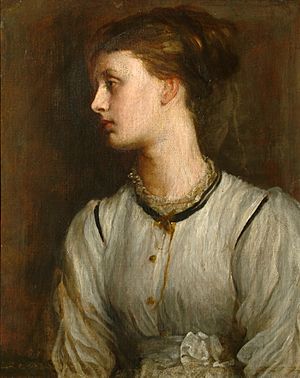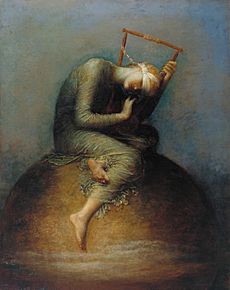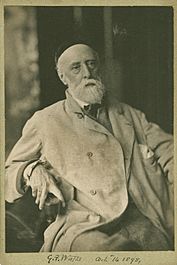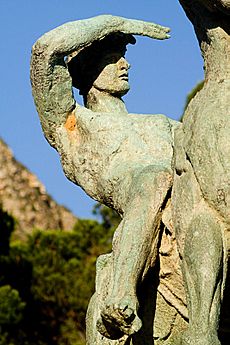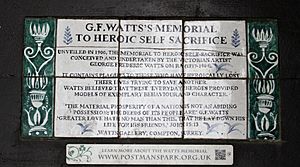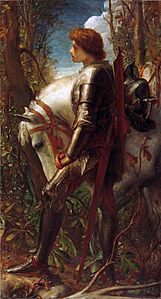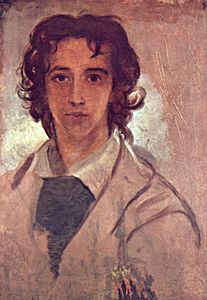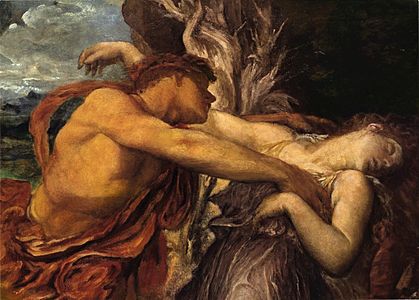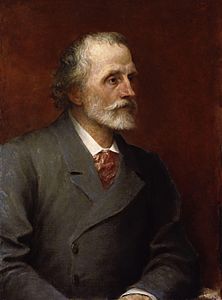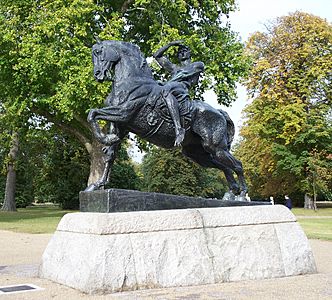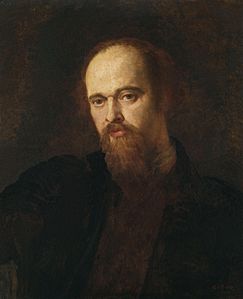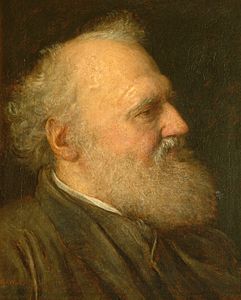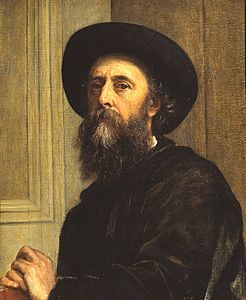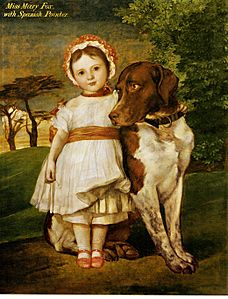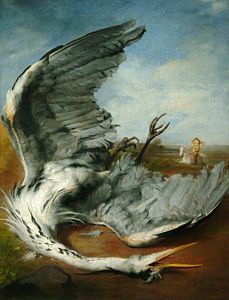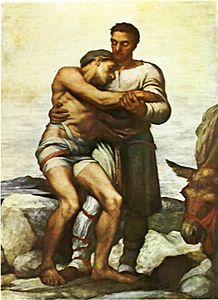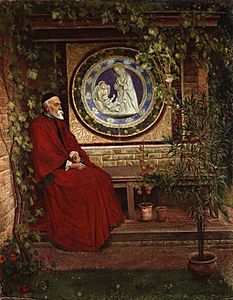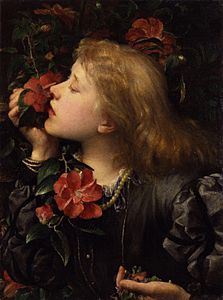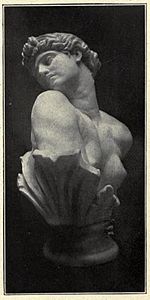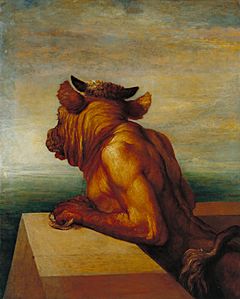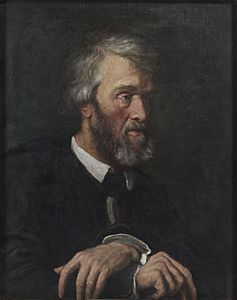George Frederic Watts facts for kids
Quick facts for kids
George Frederic Watts
|
|
|---|---|
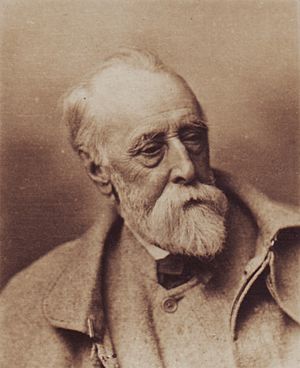
George Frederic Watts, c. 1902
|
|
| Born | 23 February 1817 Marylebone, Middlesex, England
|
| Died | 1 July 1904 (aged 87) London, England
|
| Nationality | English |
| Education | William Behnes Royal Academy Schools |
| Known for | Painting, sculpture |
|
Notable work
|
Hope Love and Life Physical Energy |
| Movement | Symbolist |
| Spouse(s) |
|
| Awards | Order of Merit |
| Patron(s) | Alexander Constantine Ionides |
| Signature | |
George Frederic Watts OM RA (born February 23, 1817 – died July 1, 1904) was a famous British painter and sculptor. He was known for his Symbolist art, which used symbols to express ideas. Watts once said, "I paint ideas, not things." He became very well-known for his paintings like Hope and Love and Life. These artworks were meant to be part of a big series called the "House of Life." This series aimed to show human feelings and dreams using a universal language of symbols.
Contents
Early Life and Learning
Watts was born in Marylebone, London, on the same day as the famous musician George Frederic Handel. Watts was named after him. His father was a piano maker and not very rich. Watts was often sick when he was young, and his mother died early. His father taught him at home, focusing on a strict Christian view and classic books like the Iliad. The religious lessons made him dislike traditional religion later on, but the classic stories always inspired his art.
He showed artistic talent very early. At just 10 years old, he started learning sculpture from William Behnes. He also spent a lot of time studying the ancient Greek sculptures called the Elgin Marbles. He later said he learned everything from them. At 18, he joined the Royal Academy Schools to study art.
Watts's Art Career
First Art Shows
Watts first showed his art at the Royal Academy in 1837. He displayed a painting called "The Wounded Heron" and two portraits. He didn't stay at the Academy for long. He preferred to learn through his own experiments and hard work, always looking to ancient Greek sculpture for inspiration. He also began painting portraits, getting support from his friend Alexander Constantine Ionides.
Winning a Mural Prize
Watts became famous when he entered a competition in 1843. He submitted a drawing called Caractacus to design murals for the new Houses of Parliament in London. These murals were meant to show patriotic stories. Watts won a first prize of £300. Even though he didn't end up painting much at Westminster, this competition gave him the idea for his big dream: to cover a building with murals showing how humanity has grown and changed.
Travels in Italy
The prize money from the Westminster competition allowed Watts to visit Italy in 1843. He stayed there for a long time and became friends with the British ambassador, Henry Fox, 4th Baron Holland, and his wife, Augusta. He painted a portrait of Lady Holland for them. While in Italy, Watts also started painting landscapes. He was greatly inspired by Michelangelo's Sistine Chapel and Giotto's Scrovegni Chapel. In 1847, he entered another competition for the Houses of Parliament with his painting of Alfred the Great, called Alfred Inciting the Saxons to Prevent the Landing of the Danes by Encountering them at Sea.
Back in Britain
Watts left Florence in April 1847, planning a short trip back to London, but he ended up staying. He won another first-class prize of £500 for his painting at the Westminster Hall exhibition. The government bought this painting, and it was hung in the House of Commons. This led to a new project: a fresco of "St George overcomes the Dragon" for the Houses of Parliament. He started it in 1848 and finished in 1853.
Back in Britain, he couldn't find a building large enough for his grand fresco plan based on his Italian experiences. However, he did create a huge fresco (45 feet by 40 feet) for the Great Hall of Lincoln's Inn. It was called Justice, A Hemicycle of Lawgivers (finished 1859) and was inspired by Raphael's The School of Athens. Because of this, most of his major works ended up being oil paintings, some of which were studies for his "House of Life" series.
The Prinsep Family
Watts met Henry Thoby Prinsep and his wife Sara. He became part of their group of artistic friends, which included Sara's seven sisters and the photographer Julia Margaret Cameron. In 1850, Watts moved into Little Holland House with the Prinseps. He lived there with them and their artistic gatherings for 21 years.
Busy Painting Years
While working on the Lincoln's Inn project, Watts also painted many other pictures and portraits. In 1849, he showed two of his most famous symbolic paintings: "Life's Illusions" and "The people that sat in darkness." In 1850, he showed his desire to help humanity with "The Good Samaritan." This painting honored the kindness of Thomas Wright of Manchester, and Watts gave the painting to that city. From the late 1840s, he painted many portraits in France and England. Other important paintings from this time include “Sir Galahad” (1862), “Ariadne in Naxos” (1863), “Time and Oblivion” (1864), and “Thetis” (1866).
Teaching and More Travels
Watts only ever had two students: Henry Prinsep's son Valentine Cameron Prinsep and John Roddam Spencer Stanhope. Both remained his friends. While living at Little Holland House, Watts's large paintings were shown in Whitechapel by his friend, the social reformer Canon Samuel Barnett. He finally received a commission for the Houses of Parliament, finishing his The Triumph of the Red Cross Knight in 1852–53. He also took a short trip back to Italy in 1853 and traveled with Charles Thomas Newton to dig at Halicarnassus in 1856–57. In 1856, Watts visited Lord Holland in Paris and painted portraits of famous French people like Adolphe Thiers and Jérôme Bonaparte. After these trips, he spent most of his life working quietly in his home studios.
A Short Marriage
In the 1860s, Watts's art showed the influence of Dante Gabriel Rossetti, often using rich colors and showing pleasure. One of these paintings was a portrait of his young wife, the actress Ellen Terry. She was 30 years younger than him. They married on February 20, 1864, just before her 17th birthday. Their marriage ended less than a year later.
Later Art Influences
Watts's connection with Rossetti and the Aesthetic movement changed in the 1870s. His work began to mix classic art styles with a rough, energetic look. This was to show the strong, changing energies of life and how things evolve. These works became part of a new version of his "House of Life" series. Watts hoped to show how different "mythologies of the races [of the world]" developed, combining spiritual ideas with modern science, especially Darwinian evolution.
Later Life and New Homes
As the lease on Little Holland House was ending, Watts had a new home built nearby in London in the early 1870s. He also bought a house in Freshwater, Isle of Wight, where his friends Julia Margaret Cameron and Lord Tennyson already lived. To stay close to the Prinsep family, he built a house for them near Freshwater and adopted their relative Blanche Clogstoun. In 1877, his divorce from Ellen Terry was finalized. His friend Coutts Lindsay opened the Grosvenor Gallery, which became the perfect place for Watts to show his art for the next ten years.
In 1886, when he was 69, Watts married again to Mary Fraser Tytler, a Scottish designer and potter who was 36. In 1891, he bought land near Compton, in Surrey. The couple named their house "Limnerslease" and built the Watts Gallery nearby. This museum was dedicated to his work and was the first gallery in Britain built only for one artist. It opened in April 1904, shortly before Watts died.
Watts Mortuary Chapel
Watts paid for the nearby Watts Mortuary Chapel, which his wife Mary designed. He also painted a version of The All-Pervading for the altar just three months before he passed away. Both Limnerslease and the chapel are now cared for by the Watts Gallery. In 2016, Watts's art studio in the house was reopened. It was restored to look as it did when Watts lived there, using old photographs.
Art Collections and Awards
Many of Watts's paintings are now at Tate Britain. He gave 18 of his symbolic paintings to Tate in 1897 and three more in 1900. Some of these are now on display at the Watts Gallery.
Watts was offered a special honor, a baronetcy, by Queen Victoria twice, but he refused. He was elected as an Academician to the Royal Academy in 1867. In 1902, he agreed to be one of the first members of the new Order of Merit (OM). He said he accepted it for all English artists. He received the award from King Edward VII in August 1902.
Later Paintings
In his last paintings, Watts's artistic ideas changed into mystical images. One example is The Sower of the Systems, which seems to hint at abstract art. This painting shows God as a shape that is hard to see, surrounded by bright stars and clouds of gas. Some of Watts's other late works also seem similar to the paintings from Picasso's Blue Period.
Portrait Painting
Watts was also admired for his portraits. He painted many important people of his time, hoping to create a "House of Fame" with their images. In his portraits, Watts tried to show both a person's calm strength and their active energy. He was also known for showing the signs of stress and age on people's faces. Many of his portraits of British people are now in the National Portrait Gallery. He donated 17 in 1895, and more than 30 were added later. Some of the famous people he painted include François Guizot (1848), Sir Henry Rawlinson, Tennyson (1856), Gladstone (1858 and 1865), and Thomas Carlyle.
Physical Energy Sculpture
Even though he is best known as a painter, Watts was also a sculptor. After finishing a sculpture for the Duke of Westminster, Watts started working on a new clay model of a horse and rider in 1883. This sculpture was not meant to be a specific person. He was still working on it when he died in 1904. The clay model was given to the Watts Gallery. In 1904, the first bronze copy of the sculpture was shown at the Royal Academy's summer exhibition.
Physical Energy later traveled to Cape Town, South Africa, to be part of a memorial for Cecil Rhodes. In 1907, another copy was made after Watts's death and placed in Kensington Gardens, London. Watts had wanted to give this sculpture to the British Government for the nation. A third copy, made in 1959, is in Harare, Zimbabwe.
Physical Energy was Watts's biggest public sculpture project. It represents human strength and our constant effort to improve. Watts said it was "a symbol of that restless physical impulse to seek the still unachieved in the domain of material things." He also believed that everyone having access to great art would greatly benefit the country.
Memorial to Heroic Self-Sacrifice
Watts admired royalty and had painted important figures like the Prince of Wales. In 1887, he suggested creating a Memorial to Heroic Self-Sacrifice. This memorial would honor ordinary people who had died saving others and might otherwise be forgotten. His idea was not accepted at first. But in 1898, a vicar named Henry Gamble suggested the memorial could be built in Postman's Park in London.
The memorial was opened in 1900, but it wasn't finished. It included a 50-foot (15 meter) wooden shelter designed by Ernest George. Inside, there was a wall with space for 120 ceramic tiles to remember heroes. These tiles were to be designed by William De Morgan. When it opened, only four tiles were in place. Watts died in 1904, and his wife Mary Watts continued the project.
Gallery
-
Sir Galahad
-
Portrait of George Meredith
-
Sir Leslie Stephen, 1878
-
The wounded heron, 1837 (Watts Gallery)
-
The Good Samaritan
-
Choosing (Ellen Terry), ca. 1864
-
Portrait of Thomas Carlyle
See also
 In Spanish: George Frederick Watts para niños
In Spanish: George Frederick Watts para niños


